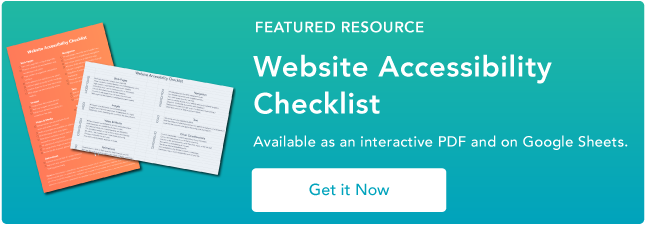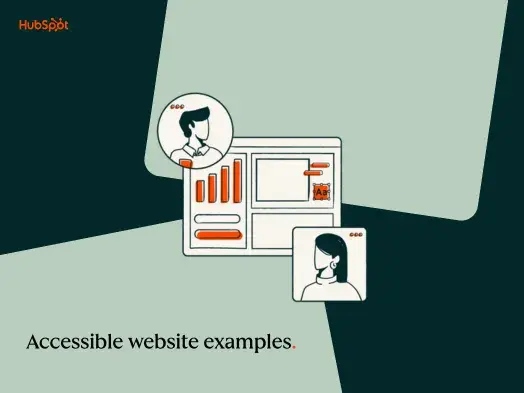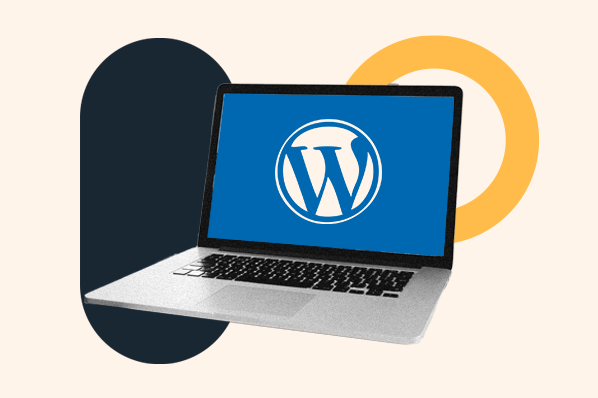The Need for Improved Accessibility
According to the CDC, one in four Americans — approximately 61 million people — have "a disability that impacts major life activities.” These disabilities fit into six major categories:
- Mobility: Difficulties walking, climbing stairs, and accessing physical infrastructure
- Cognition: Difficulty concentrating, remembering, or making decisions
- Hearing: Difficulty hearing conversations and/ or digital media
- Vision: Difficulty reading text or watching videos
- Independent Living: Difficulty with basic daily tasks associated with independent living, such as running errands or cooking food
- Self-care: Difficulty with day-to-day behaviors such as dressing or bathing
By focusing on this accessibility initiative and altering your website for users with disabilities like these, your business increases its pool of potential customers by 25% and builds greater loyalty among customers.
Now let's review what web accessibility testing entails.
As noted by Web Accessibility Initiative (WC3), "... accessibility evaluation is more formalized than usability testing generally." And well-designed accessibility testing focuses on four goals:
- Addressing the needs of people with all disabilities
- Balancing the needs of people with differing disabilities
- Matching these needs to optimal techniques
- Using clear language to express those needs and techniques
Put simply, web accessibility testing ensures the functions and features that are put in place to increase website accessibility are working as intended.
What To Test For
Website testing for accessibility should evaluate two key outcomes: universality and usability.
Universality covers elements and aspects of your site that are usable for everyone. For example, lower curbs on sidewalks and walkways provide universal access; both able-bodied consumers and those with mobility issues benefit.
Usability, meanwhile, speaks to the simplicity and functionality of accessible design elements. The easier to use your website, the better your chances of capturing visitor interest.
To effectively test web accessibility, it’s worth considering each of the six CDC categories we mentioned above:
- Mobility: How will those with mobility challenges access your website? As noted by Karl Groves, founder of the Tenon.io web accessibility platform, there’s a simple starter test: Unplug your mouse. Can you interact with all controls on your website? Can you see which controls are currently active? Do command orders make sense? If the answer is no, you need to improve keyboard support.
- Cognition: How complex are the forms and menus on your website? Are they contextually-relevant and easy to identify for those with cognitive difficulties? Does each form field indicate exactly what’s required from users? If you have form requirements hiding in field boxes, consider moving them outside.
- Hearing: If your site has multiple videos or sound clips, do you have options for those who are hearing impaired? This includes closed captioning for videos or transcripts for podcasts, product descriptions or other audio media.
- Vision: On the flip side, does your site support audio descriptions and include context-first text that makes it easy for impaired visitors using text-to-voice software to quickly find what they need?
- Independent Living: Ease-of-use is paramount here. Users with independent living challenges are often able to take on increasingly complex tasks as long as they include simple and straightforward steps. This is why a streamlined site design makes it easier for these visitors to find what they’re looking for.
- Self-care: Many of those who struggle with self-care due to physical or cognitive disabilities still possess remarkable mental prowess — here, easily-scalable text and image elements can save these users needless frustration.
It’s one thing to recognize the need for web accessibility testing — it’s another to deploy effective tests across your site at scale.
Below let's look at some of the best accessibility testing tools to help streamline your evaluation process and deliver reliable outcomes to all visitors.
We'll start with tools that require you to manually test each page one at a time. Then we'll look at tools that automate the testing process for you.
Manual Accessibility Testing Tools
While the accessibility testing tools below require you to manually test one page at a time, they can still save you a lot of time by identifying accessibility errors that you would have had to manually identify otherwise. This makes it easier for site owners who aren't experts in accessibility requirements or standards to create and maintain websites that provide excellent experiences to all users.
1. BrowserStack

BrowserStack offers a platform for comprehensive accessibility testing, reporting, and monitoring. Their suite of features is designed to identify basic and advanced issues through a unified platform. Built on WCAG principles, its test engine covers compliance with ADA, AODA, Section 508, and the upcoming EAA.
It has auto-generated reports with issue & build health summaries, historical trends, & insights. A first in the mobile accessibility landscape, BrowserStack App Accessibility offers Screen Reader support, for VoiceOver on iOS alongside TalkBack on Android. Teams can upload and scan native, cross-platform, and hybrid apps in a unified workflow.
2. WAVE
 WAVE was developed by accessibility firm WebAIM and Utah State University. Testing is simple — just enter your webpage address into the provided form field, or use the offered Firefox or Chrome extensions.
WAVE was developed by accessibility firm WebAIM and Utah State University. Testing is simple — just enter your webpage address into the provided form field, or use the offered Firefox or Chrome extensions.
WAVE can quickly identify potential contrast errors, test size issues, confusing structural elements, and accessible rich internet application (ARIA) challenges such as undefined elements.
3. accessScan
accessScan is a free tool developed by accessiBe, a market leader in web accessibility software. Automatically scanning the submitted landing page, accessScan then performs a quick but thorough auditing process. Once completed, accessScan will tell you whether or not your site is WCAG compliant. You can download a PDF detailing any and all accessibility gaps your site may have.
4. A11y Color Contrast Accessibility Validator
 A11y Color Contrast Accessibility Validator is a free tool that checks the color contrast of your webpage to help identify the optimal contrast between text and backgrounds.
A11y Color Contrast Accessibility Validator is a free tool that checks the color contrast of your webpage to help identify the optimal contrast between text and backgrounds.
5. ACTF aDesigner
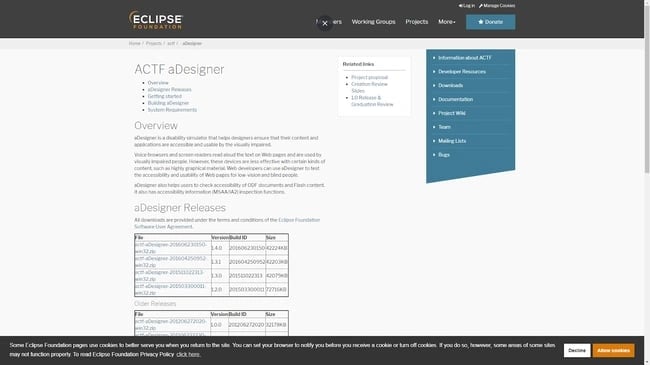
ACTF aDesigner is a free disability simulator that evaluates how well website text and content work with voice browsers and screen readers to help you identify areas of improvement.
6. CSS & HTML Validator
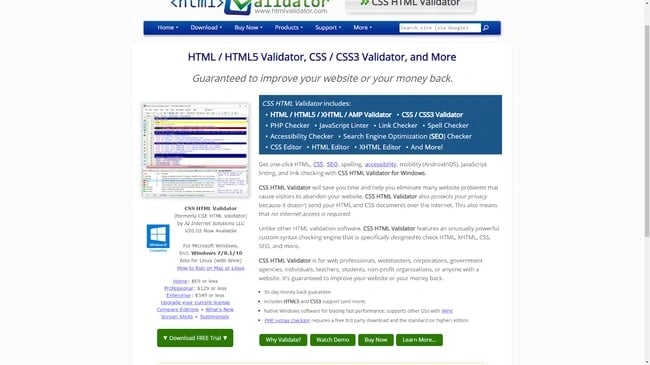
CSS & HTML Validator checks your site for CSS, HTML, PHP, JavaScript, and spelling errors. This will help you catch everything from misclassified structural elements to improperly functioning forms or text issues that could prevent reading and transcription services from delivering accurate outputs.
7. Siteimprove

Siteimprove provides you with a series of tools used to improve accessibility on your website. It prioritizes issues based on where the problem is located, its conformance level, and how difficult it is to fix. That way, you can address every compliance issue in your content and work towards a more accessible website altogether.
8. ComplianceSheriff

ComplianceSheriff audits your website to ensure it complies with web accessibility standards in the US, EU, Canada, and more. Customers can quickly identify, prioritize, and correct problems throughout their sites, and track their improvement.
9. HTML_CodeSniffer
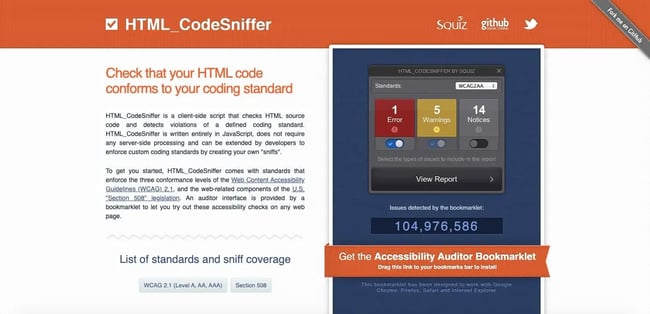
HTML_CodeSniffer can test your HTML source code against a selected guideline (either Web Content Accessibility Guidelines (WCAG) 2.1 or U.S. "Section 508" legislation). It can detect violations of any of its predefined rules, or any custom ones you add.
10. tota11y

Tota11y is an accessibility visualization toolkit designed to enable any user to understand and fix accessibility violations while learning best practices — without needing any prior knowledge. tota11y is a single JavaScript file that inserts a small button in the bottom corner of a document or web page. Click on it and you’ll see a toolbar with several plugins that annotate elements on the page, like images without alt text, labels with insufficient color contrast, and more.
Automated Accessibility Testing Tools
Rather than require you to manually test one page at a time, automated accessibility testing tools can scan your entire site (or multiple sites) for accessibility errors. Some of these tools will not only identify errors on your website — they'll correct them for you.
The automated tools below are ideal for larger websites with hundreds to thousands of web pages.
11. Tenon

Tenon is an API-first, automated accessibility testing tool with rapid remediation service. Designed to ensure every user has equal access to your website, it can fix any accessibility issues or gaps on your site while testing is ongoing.
12. Evinced

Evinced is an honest web accessibility testing tool. We say honest because Evinced tells you from the start, "there's no silver bullet for accessibility compliance." This tool helps you weave web accessibility into your software development process, so you'll always be aware of accessibility compliance and how it may impact your website.
13. Access Alchemy
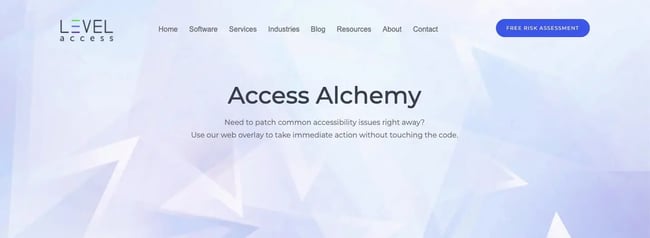
Access Alchemy is a JavaScript-based browser extension that can immediately deploy automated fixes for common accessibility issues and violations. You just have to define fixes, like correct alternative text for images or proper form labels, and Access Alchemy will automatically apply them anywhere on your site with the same issue.
14. TPGi

TPGi provides you with a free WCAG scan, which gives you a general overview of your website's accessibility. It also offers a full-scale audit service that evaluates multiple templates across your website for accessibility compliance.
15. Pope Tech
 Pope Tech is basically the automated version of WAVE. It will quickly scan your site for accessibility errors, offer explanations for what each issue means and how it’s affecting users, and provide suggestions for fixing them.
Pope Tech is basically the automated version of WAVE. It will quickly scan your site for accessibility errors, offer explanations for what each issue means and how it’s affecting users, and provide suggestions for fixing them.
16. SortSite Desktop

Available for Mac or Windows, SortSite Desktop is a simple testing tool that can analyze an entire website in one click. It checks each page against 1200+ checkpoints, including accessibility guidelines, SEO guidelines, privacy laws, and more.
17. Dynomapper
 Dynomapper evaluates a website’s HTML code for existing accessibility problems by testing against published guidelines. You can schedule monthly automated tests and receive email notifications of accessibility problems as well as an overall Accessibility Score.
Dynomapper evaluates a website’s HTML code for existing accessibility problems by testing against published guidelines. You can schedule monthly automated tests and receive email notifications of accessibility problems as well as an overall Accessibility Score.
18. IBM Dynamic Assessment Plugin

The IBM Dynamic Assessment Plugin is a Chrome browser extension that scans web applications to identify accessibility issues — including violations, potential violations, anything that should be manually checked — and recommend potential fixes. It also outlines each issue in detail and provides code examples and best practices for adhering to web accessibility guidelines.
19. Tanaguru

Tanaguru is quite visual, with various charts measuring compliance and an overall evaluation circled at the top of the results page. The rest of the page shows which elements pass or fail on your website in terms of accessibility compliance. My favorite part though is the loading screen that shares lighthearted expressions like, "firing up the engines," and, "manning the torpedoes," while you wait for the tool to complete its review.
20. Rocket Validator

Rocket Valdiator is a web crawler that can scan up to 5,000 pages for accessibility and HTML5 conformance with a single click. Just enter a starting URL when you want a report, or schedule a report by entering the URL, how many pages you want scanned, and how often.
21. UsableNet AQA

UsableNet AQA is a cloud-based accessibility management platform. It can test and identify accessibility issues on individual web pages as well as end-to-end user flows. It also allows you to preview how your site works with screen readers — an advanced functionality that sets it apart from other platforms.
22. forApp

forApp is an online service for ensuring compliance with mobile application accessibility standards. It automatically inspects apps, and provides results that can be downloaded in PDF format to share with your team.
Begin Using Web Accessibility Testing Tools
Web accessibility testing ensures your site accommodates all visitors with specific solutions, universal controls, and improved ease-of-use. Using a combination of the manual and automated testing tools mentioned above can ensure you don't overlook any errors or gaps and do provide the best experience to all users on your website.
Editor's note: This post was originally published in March 2020 and has been updated for comprehensiveness.
Web Accessibility


.png)
